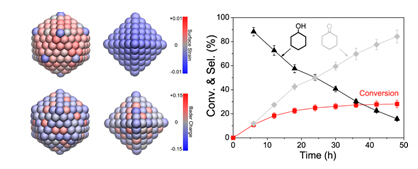Great Progress in the Investigation of the Influence of Twinned Structures in Catalysis

Surface strain and Bader charge of Au75Pd25 icosahedrons and octahedrons (left) and time course of the oxidation of cyclohexane catalyzed by Au75Pd25 icosahedrons (right).
The enhancement of catalytic properties toward the aerobic oxidation of cyclohexane has met a bottleneck, mainly in the fabrication of highly efficient catalysts to activate oxygen molecules and promotion of the selectivity of cyclohexanone. Twinned alloy nanocrystals exhibited remarkable performance in the oxidation of cyclohexane due to their unique twinned structure and synergetic effect. However, the mechanism of the effects of twin defects in catalysis has not been fully elucidated to date.
Based on the mechanism of oxidative etching, the research group of Prof. Zeng has successfully synthesized Au75Pd25 icosahedrons and octahedrons by adding different amounts of iodide ions. Both enclosed by the same crystal facets, icosahedrons are constructed with twin defects, while octahedrons are single crystals. Hence, the successful synthesis of icosahedrons and octahedrons provides an ideal platform in the study of different catalytic properties and reaction mechanism. The turnover frequency number of Au75Pd25 icosahedrons reached 15 106 h−1, almost three times as high as that of Au75Pd25 octahedrons for aerobic oxidation of cyclohexane. Besides, the selectivity to cyclohexanone reached 84.3% using Au75Pd25 icosahedrons. Density functional theory calculations along with X-ray photoelectron spectroscopy examinations reveal that twins in Au75Pd25 icosahedrons predominately generated tensile surface structure and highly negative charge density surface, which could enhance the catalytic activity. This research concerning twinned structure is anticipated to raise widespread interests about potential use of twins in more aerobic oxidation reactions.
This work was supported by MOST of China, the National Natural Science Foundation of China, Strategic Priority Research Program B of the CAS and Fundamental Research Funds for the Central Universities.
Source: http://pubs.acs.org/doi/abs/10.1021/ja511596c
Back
